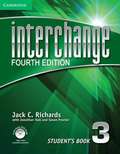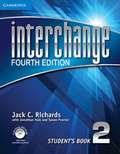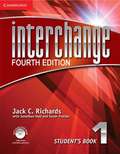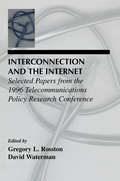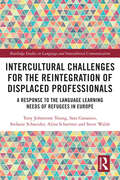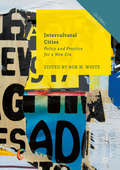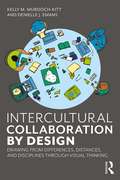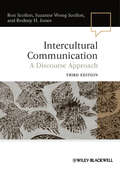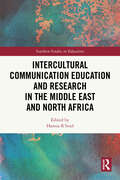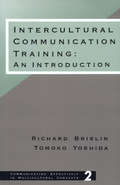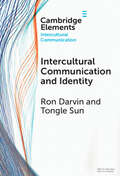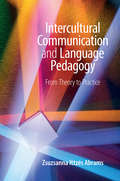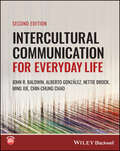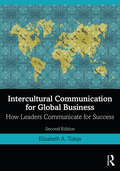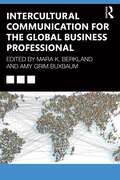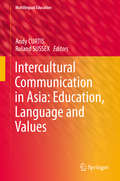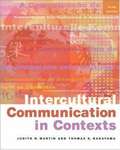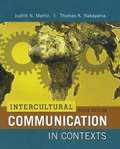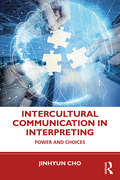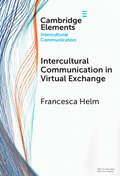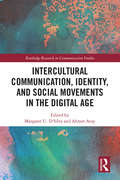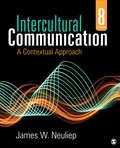- Table View
- List View
Interchange (Level #3)
by Jack C. RichardsInterchange offers a complete set of tools for learning how to communicate in English.
Interchange Level 1 Student's Book (Fourth Edition)
by Jack C. Richards Jonathan Hull David Bohlke Susan ProctorInterchange offers a complete set of tools for learning how to communicate in English. Interchange Fourth Edition is a four-level series for adult and young-adult learners of English from the beginning to the high-intermediate level.
Interchange Level 1 Student's Book (Fourth Edition)
by Jack C. Richards Jonathan Hull David Bohlke Susan ProctorInterchange offers a complete set of tools for learning how to communicate in English. Interchange Fourth Edition is a four-level series for adult and young-adult learners of English from the beginning to the high-intermediate level. Interchange Fourth Edition is a four-level series for adult and young-adult learners of English from the beginning to the high-intermediate level. Student's Book, Level 1 builds on the foundations established in the Intro level for accurate and fluent communication, extending grammatical, lexical, and functional skills. The Student's Book contains 16 teaching units, progress checks, additional Interchange activities, and a Grammar Plus section that provides additional grammar explanations and practice.
Interconnection and the Internet: Selected Papers From the 1996 Telecommunications Policy Research Conference (LEA Telecommunications Series)
by Christopher H. Sterling David Waterman Gregory L. RosstonThe Telecommunications Act of 1996 and the Federal Communications Commission's Local Competition Order are just two examples of the continuing monumental and far-reaching changes occurring throughout the telecommunications industry. At the 1996 Telecommunications Policy Research Conference (TPRC) -- an annual forum for dialogue among scholars and the policymaking community on a wide range of telecommunications issues -- leading industry and academic researchers presented results of their research and insights in key areas of activity, including: *interconnection and competition; *Internet growth and commerce; *Internet regulation and control; and *the political economy of telecommunications regulation. The best of the 1996 TPRC papers are included here, representing the forefront of research in the telecommunications industry. The third in an annual LEA series of volumes based on this important conference, this collection reflects the rapid economic, technological, and social development of telecommunications. It also reflects the current state of research thinking on this issue and provides a foundation for further telecommunications policy analysis.
Intercultural Challenges for the Reintegration of Displaced Professionals: A Response to the Language Learning Needs of Refugees in Europe (Routledge Studies in Language and Intercultural Communication)
by Steve Walsh Tony Johnstone Young Sara Ganassin Stefanie Schneider Alina SchartnerThis book critically reflects on the challenges faced by refugee aspirant professionals in securing employment and the ways in which professional intercultural competence development and attendant language learning practices can help facilitate the professional (re)integration in these communities. The volume draws on data from a large-scale research project that saw refugee aspirant professionals, researchers, and volunteer language teachers working together to develop and operationalise key intercultural skills needed for professional employment in the UK, the Netherlands, and Austria, ultimately culminating in a toolkit of free online resources co-designed to meet the needs of communities and facilitate the development of these practices across Europe. Detailed analyses of the data drawn from the project allow for critical reflections on co-production in intercultural spaces and researchers’ positionality, power relations, and ethical choices in multilingual contexts. Taken together, the book offers both theoretical and practical considerations for application beyond the European context toward better facilitating the professional (re)integration of migrant communities on a more global scale. The book will be of particular interest to students and researchers in intercultural communication, refugee studies, and language education.
Intercultural Cities
by Bob W. WhiteThis book sets out to explore the political and social potential of intercultural policy for cities by bringing together advances in the areas of urban planning and intercultural theory. In recent years, demographic changes in cities in many parts of the world have led to increasing concerns about inter-ethnic tensions, social inequality, and racial discrimination. By virtue of their intermediate status, cities are in a particularly good position to design policy and programs that contribute to the well-being of all citizens, regardless of their origins. Certain cities have made significant advances in this domain, but until now very little work has been done to understand the specificity of work in the area of intercultural policy frameworks. The overall goal of this volume is to facilitate conversations between researchers and practitioners in their efforts to make cities more inclusive. This volume is the result of a series of on-going collaborations between academics and practitioners and it includes a number of original case studies that explain the evolution of intercultural policy from the point of view local actors. This collection will be of interest especially to policymakers and urban planners, but also to scholars and students in the areas of urban studies, public policy, anthropology, sociology, globalization and social sciences more generally. By leveraging recent advances in the field of intercultural policy and practice, this volume sheds light on the conditions and strategies that make intercultural cities a part of a common future.
Intercultural Collaboration by Design: Drawing from Differences, Distances, and Disciplines Through Visual Thinking
by Kelly M. Murdoch-Kitt Denielle J. EmansIntercultural Collaboration by Design introduces a framework for collaborating across cultures and learning to use multicultural perspectives to address pressing global issues. This handbook helps people work, learn, and teach across cultures. Through the activities highlighted in this book, virtual and intercultural teams will find a practical route for initiating and sustaining productive work across disciplinary and social barriers. Teams can craft a plan to achieve their goals by selecting the activities that best meet their needs and interests. First-person anecdotes from the authors demonstrate how the activities encourage teams to embrace diverse perspectives in order to create innovative solutions. With over 30 hands-on activities, this book will be of great interest to diverse teams from a variety of disciplines who want to enhance intercultural learning and co-working. Whether in the classroom or workplace, the activities are appropriate for a variety of collaboration contexts, without a need for background in art or design.
Intercultural Communication
by Rodney H. Jones Suzanne Wong Scollon Ron ScollonThis newly revised edition is both a lively introduction and practical guide to the main concepts and challenges of intercultural communication. Grounded in interactional sociolinguistics and discourse analysis, this work integrates theoretical principles and methodological advice, presenting students, researchers, and practitioners with a comprehensive and unified resource. Features new original theory, expanded treatment of generations, gender and corporate and professional discourse Offers improved organization and added features for student and classroom use, including advice on research projects, questions for discussion, and references at the end of each chapter Extensively revised with newly added material on computer mediated communication, sexuality and globalization
Intercultural Communication Education and Research in the Middle East and North Africa (Southern Studies in Education)
by Hamza R’boulThis edited volume gathers insights into the production of knowledge about interculturality in education and research in the Middle East and North Africa (MENA).The MENA region is seen in this book as a space with unique circumstances, conditions and complexities that need to be thoroughly explored and further unpacked. The book defines intercultural communication education and research broadly, but focuses on how teaching and researching interculturality is understood and practiced in MENA formal education classrooms and in various training situations such as business, politics, media and communication. This edited volume aims to (a) navigate representations of intercultural communication in education and research, starting from the premise that interculturality is not only a theory of analysis but also an activism for social and epistemic justice, (b) investigate specific phenomena, challenges and issues in education and research, including concepts/notions such as acculturation and intercultural understanding/empathy, and (c) explore subfields of knowledge such as sense-making and intercultural pragmatics, and specific contexts of interculturality such as immigrants, exchange programs and student mobilities.This book will be valuable read for students, educators, scholars and policymakers interested in intercultural communication and education in the region, as well as language and sociology more broadly.
Intercultural Communication Training: An Introduction
by Tomoko Yoshida Richard W. BrislinThis unique handbook provides an organizational framework for planning and establishing intercultural communication training programs. Drawing from intercultural communication and cross-cultural training, this guide emphasizes those aspects of training that explicitly involve face-to-face communication. The approaches covered apply to any situation where good personal relations and effective communication need to be established with people from different cultural backgrounds.
Intercultural Communication and Identity (Elements in Intercultural Communication)
by Ron Darvin Tongle SunThis Element asserts how identity as a construct enables a critical awareness of how speakers position themselves and are positioned by others in intercultural encounters. It discusses how identity vis-à-vis culture has been theorized through social psychological, poststructuralist, and critical lenses, and how identity is discursively constructed and mediated. Rejecting essentialist notions of language and culture, this Element demonstrates how inscriptions of identity such as race, ethnicity, nationality, and class can be used to critically examine the dynamics of situated intercultural encounters and to understand how such interactions can index competing and colluding ideologies. By examining identity research from different parts of the world, it casts a light on how identities are performed in diverse intercultural contexts and discusses research methodologies that have been employed to examine identity in intercultural communication.
Intercultural Communication and Language Pedagogy: From Theory To Practice
by Zsuzsanna I. AbramsLearning a new language offers a unique opportunity to discover other cultures as well as one's own. This discovery process is essential for developing 21st-century intercultural communication skills. To help prepare language teachers for their role as guides during this process, this book uses interdisciplinary research from social sciences and applied linguistics on intercultural communication for designing teaching activities that are readily implemented in the language classroom. Diverse language examples are used throughout the book to illustrate theoretical concepts, making them accessible to language teachers at all skill levels. The chapters introduce various perspectives on culture, intercultural communicative competence, analyzing authentic language data, teaching foreign/second languages with an intercultural communication orientation, the intercultural journey, the language-culture-identity connection, as well as resolving miscommunication and cultural conflict. While the immediate audience of this book is language teachers, the ultimate beneficiaries are language learners interested in undertaking the intercultural journey.
Intercultural Communication for Everyday Life
by John R. Baldwin Suchitra Shenoy-Packer Robin R. Coleman Alberto Gonzal¿zWritten for students studying intercultural communication for the first time, this textbook gives a thorough introduction to inter- and cross-cultural concepts with a focus on practical application and social action. Provides a thorough introduction to inter- and cross-cultural concepts for beginning students with a focus on practical application and social action Defines “communication” broadly using authors from a variety of sub disciplines and incorporating scientific, humanistic, and critical theory Constructs a complex version of culture using examples from around the world that represent a variety of differences, including age, sex, race, religion, and sexual orientation Promotes civic engagement with cues toward individual intercultural effectiveness and giving back to the community in socially relevant ways Weaves pedagogy throughout the text with student-centered examples, text boxes, applications, critical thinking questions, a glossary of key terms, and online resources for students and instructors Online resources for students and instructors available upon publication at www.wiley.com/go/baldwin
Intercultural Communication for Everyday Life
by John R. Baldwin Alberto González Ming Xie Chin-Chung Chao Nettie BrockINTERCULTURAL COMMUNICATION FOR EVERYDAY LIFE Face the global challenges of the future with this accessible introduction to communication across boundaries Communication between cultures can be challenging in a number of ways, but it also carries immense potential rewards. In an increasingly connected world, it has never been more important to communicate across a range of differences created by history and circumstance. Contributing to global communities and rising to meet crucial shared challenges—human rights disputes, refugee crises, the international climate crisis—depends, in the first instance, on a sound communicative foundation. Intercultural Communication for Everyday Life provides a thorough introduction to this vital subject for students encountering it for the first time. Built around a robust and multifaceted definition of culture, which goes far beyond simple delineation of national boundaries, it offers an understanding of its subject that transcends US-centricity. The result, updated to reflect dramatic ongoing changes to the interconnected world, is essential for students of cross—cultural communication and exchange. Readers of the second edition of Intercultural Communication for Everyday Life readers will also find: Accessible definitions of core concepts Revised and updated chapters reflecting the COVID-19 crisis, climate change challenges, and more An all-new chapter on social media as a tool for intercultural communication Intercultural Communication for Everyday Life is essential for students and other readers seeking a foundational overview of this subject.
Intercultural Communication for Global Business: How Leaders Communicate for Success
by Elizabeth A. TulejaThis book brings together principles and new theories in intercultural communication in a concise and practical manner, focusing on communication as the foundation for management and global leadership. Grounded in the Cultural Intelligence Model, this compact text examines the concepts associated with understanding culture and communication in the global business environment to help readers: • Understand intercultural communication processes. • Improve self-awareness and communication in intercultural settings. • Expand skills in identifying, analyzing, and solving intercultural communication challenges at work. • Evaluate whether one’s communication has been effective. Richly illustrated with examples, activities, real-world applications, and recent case studies that make the content come alive, Intercultural Communication for Global Business is an ideal companion for any business student or manager dedicated to communicating more effectively in a globalized society.
Intercultural Communication for Global Business: How Leaders Communicate for Success
by Elizabeth A. TulejaAs concise and practical as ever, this new edition brings together principles and new theories in intercultural communication, focusing on communication as the foundation for management and global leadership. Grounded in the need for building awareness and knowledge, practicing mindfulness, and then working on skill development, this text examines the concepts associated with understanding culture and communication in the global business environment to help readers: understand intercultural communication processes; improve self-awareness and communication in intercultural settings; expand skills in identifying, analyzing, and solving intercultural communication challenges at work; and evaluate whether one’s communication has been effective. This fully updated new edition also includes completely updated case studies, with an increased emphasis on non-US perspectives, to show real-world applications across the globe. Richly illustrated with new examples and activities, this text is the ideal companion for any business student or manager dedicated to communicating more effectively in a globalized society.
Intercultural Communication for the Global Business Professional
by Mara K. Berkland Amy Grim BuxbaumThis text integrates business and communication concepts to immerse students in the global communication experiences of business professionals. The authors argue that the essentials of intercultural communication, such as nonverbal communication, conflict, meeting management, interviewing, and negotiations are most useful to burgeoning professionals when they are woven into discussions about economic systems, market forces, production processes, finance structures, and human resources priorities. Each chapter begins with an explanation of theories and key terms appropriate for introductory-level students in both business and communication, then supplements that discussion with examples that demonstrate the concepts at work. The cases chosen represent different market systems in both dominant and emerging economies, explaining the cultures of competitive markets with a global perspective rather than focusing on the United States. This book is ideal as a text for courses in international business or professional intercultural communication, or as a supplement for more general business and communication courses.
Intercultural Communication in Asia: Education, Language and Values (Multilingual Education #24)
by Roland Sussex Andy CurtisThis volume presents in-depth studies on leading themes in education policy and intercultural communication in contemporary Asia, covering empirical as well as theoretical approaches, and offering both an in-depth investigation of their implications, and a synthesis of areas where these topics cohere and point to advances in description, analysis and theory, policy and applications. The studies address key questions that are essential to the future of education in an Asia where intercultural communication is ever more important with the rise of the ASEAN Economic Community and other international initiatives. These questions include the properties of the increasing globalisation of communication and how it plays out in Asia, especially but not exclusively with reference to English, and how we can place intercultural communication in this context, as well as studies that highlight intercultural communication and its underlying value systems and ideologies in Asia.
Intercultural Communication in Contexts (3rd edition)
by Judith N. Martin Thomas K. NakayamaAn in-depth look at the cultural context of communicating both with silence and speech.
Intercultural Communication in Contexts (6th Edition)
by Judith N. Martin Thomas K. NakayamaWith the rapid expansion of globalization, intercultural contact is now part of daily life for most of us. Intercultural Communication in Contexts examines communication in multicultural relationships and provides practitioners with the tools for effective communication amid cultural, ethnic, and religious differences. Students are introduced to the primary approaches for studying intercultural communication along with a theoretical and practical framework for applying these approaches themselves.
Intercultural Communication in Interpreting: Power and Choices
by Jinhyun ChoNavigating and resolving issues in intercultural communication is an integral part of the interpreter’s role on a daily basis. This book is an essential guide to the interpersonal dimensions of intercultural communication in a variety of key interpreting contexts: business, education, law, and healthcare. Drawing on the unique perspectives of professional interpreters, Cho focuses on two key questions that remain underexamined in the field of intercultural communication: why does intercultural communication often break down, and how do individuals manage intercultural communication issues? Each chapter deals with issues pertinent to small cultural aspects of intercultural communication, including gender, ethnic migrant communities, educational cultures among migrants of Asian backgrounds, and monolingualism/monoculturalism in courtroom and refugee interview contexts. Spanning diverse geographical domains, the book highlights the impact of macro power on interpreting as well as the significance of individual agency and micro power, which can rebalance the given communicative context. Offering a comprehensive, up-to-date, innovative, and critical perspective on intercultural communication in interpreting, this is key reading for student and professional interpreters and those on courses in language and intercultural communication.
Intercultural Communication in Virtual Exchange (Elements in Intercultural Communication)
by Francesca HelmVirtual exchange is an educational approach that uses technology to bring together people from geographically and/or culturally distant locations in sustained online interactions, often intended to develop their intercultural awareness and understanding. Though the practice has existed for several decades, it has gained popularity in recent years, in part due to the recent Covid-19 pandemic and recourse to online tools for international and intercultural learning. This Element explores intercultural communication in virtual exchange by looking at how and why culture is made relevant in the pedagogical design and framing of virtual exchanges and what impact this might have on student positioning, power dynamics, and on intercultural learning. From this framework three broad approaches are outlined, which are defined as comparative, challenge-based, and dialogue-based. Each approach is explored through examples and the opportunities, limitations, and risks for intercultural learning.
Intercultural Communication in the Chinese Workplace
by Ping DuChina's sharp economic growth at the beginning of the twenty-first century has resulted in an increasing number of people from the other countries moving to work in China. This inevitably highlights the cultural differences that are apparent between China and other global workplace cultures. This book proposes a new theoretical and methodological approach to the investigation and explanation of intercultural differences in conflict management strategies and relational (politeness) strategies in workplace settings, taking the Chinese workplace as its focus. Drawing upon social psychology, sociolinguistics and discourse analysis, the book analyses various types of data such as recordings of meetings, participant interviews, organizational documents and emails to offer a new research approach that has relevance for researchers and scholars of intercultural communication globally.
Intercultural Communication, Identity, and Social Movements in the Digital Age (Routledge Research in Communication Studies)
by Margaret U. D’Silva; Ahmet AtayThis book examines the complex and multidimensional relationship between culture and social media, and its specific impact on issues of identity and social movements, in a globalized world. Contemporary cyber culture involves communication among people who are culturally, nationally, and linguistically similar or radically different. Social media becomes a space for mediated cultural information transfer which can either facilitate a vibrant public sphere or create cultural and social cleavages. Contributors of the book come from diverse cultural backgrounds to provide a comprehensive analysis of how these social media exchanges allow members of traditionally oppressed groups find their voices, cultivate communities, and construct their cultural identities in multiple ways.This book will be of great relevance to scholars and students working in the field of media and new media studies, intercultural communication, especially critical intercultural communication, and academics studying social identity and social movements.
Intercultural Communication: A Contextual Approach
by James W. NeuliepIntercultural Communication: A Contextual Approach introduces students to the fundamental topics, theories, concepts, and themes of intercultural communication. Best-selling author James W. Neuliep presents a clear model for examining communication within a variety of contexts, including cultural, microcultural, environmental, sociorelational, and perceptual. Each chapter focuses on one context and explores the combination of factors within that context, including setting, situation, and circumstances. The updated Eighth Edition reflects the most recent research in the field and further incorporates the role of modern technology and its impact on intercultural communication. Included with this title: The password-protected Instructor Resource Site (formally known as SAGE Edge) offers access to all text-specific resources, including a test bank and editable, chapter-specific PowerPoint® slides.
